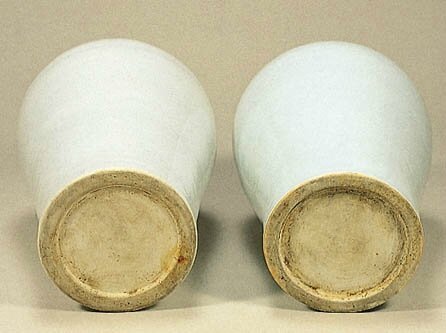Yongle Blue-and-White Porcelains at the Museum of Oriental Ceramics, Osaka
Blue-and-White Charger with Peony Design, Ming Dynasty, Yongle Period (1403-1424), d.44.7cm. Gift of SUMITOMO Group, the ATAKA Collection. The Museum of Oriental Ceramics, Osaka. © 2009 The Museum of Oriental Ceramics, Osaka.
The central field of this plate depicts, within double circles, two peonies freely interlaced by scroll-like stems. Nine types of fruit including litchies, pomegranates, loquats and vines are painted in spray style around the rim inside the dish, while the outer surface has pomegranates and scrolls. The inside of the foot rim on the base is left unglazed, revealing the compact material of the body. The work is a typical blue-and-white dish in the Yongle style.
Blue-and-White Charger with Bird and Branch Design, Ming Dynasty, Yongle Period (1403-1424), d.50.5cm. Gift of SUMITOMO Group, the ATAKA Collection.Acc. No. 10634. The Museum of Oriental Ceramics, Osaka. © 2009 The Museum of Oriental Ceramics, Osaka.
This large dish, with a diameter exceeding 50centimeters, was made using a mold and then fired skillfully to obtain an unwarped form. A delicate floral scroll graces the foliated rim. The sides of the dish are divided into 16 sections containing pomegranate, peach and other auspicious fruits. In the center, a magpie eats berries on a branch. The composition is spacious, and the brush work is both decorous and elegant, making this a typical example of early Ming dynasty pictorial design. Several other similar pieces are known to exist.
Blue-and-White Moonflask with Dragon and Wave Design, Ming Dynasty, Yongle Period (1403-1424), h.45.0cm. Gift of SUMITOMO Group,the ATAKA Collection. Acc. No. 10648. The Museum of Oriental Ceramics, Osaka. © 2009 The Museum of Oriental Ceramics, Osaka.
Exchange with the West was resumed during the Yongle period, and we can see the influence in the ceramics of the time. Islamic forms were produced with increasing diversity, and the resumption of the import of cobalt resulted in even brighter blue colors than before. This type of flask is one of the forms which appeared during this period. In the Topkapi Palace there is a similar flask with a silver lid from the 16th century. This flask features a large dragon in white against a painted blue background. The eyes of the dragon are blue cobalt dots, and its details have been incised into the clay surface. The wave scrollwork of the background is deep blue, and the color has run in the way unique to blue-and-white ware of the Yongle period. Similar shards have been excavated at Zhushan in Jingdezhen city.
Blue-and-White Covered Meiping with Inscription of Neifu (Imperial Court), Ming Dynasty, Yongle Period (1403-1424), h.34.0cm, 33.2cm. Gift of SUMITOMO Group, the ATAKA Collection. Acc. No. 10778. The Museum of Oriental Ceramics, Osaka. © 2009 The Museum of Oriental Ceramics,Osaka.
These pure white meiping vases are undecorated except for the blue inscription on the shoulders which reads "neifu". The simple brilliance of these vessels seems fit for a ware reserved for the use of the imperial court. The graceful swell of the shoulders of these meiping, together with the bold calligraphy, overflows with strength and an air of refinement. The lid with a bud-shaped knob on the top has a cylindrical support on the inside that snugly fits the mouth of the meiping. An excellent sense of design can be felt in the smart elegance that is achieved when the lid is placed on the meiping.
Blue-and-White Moonflask with Lizhi (Citrus) Design, Ming Dynasty, Yongle Period (1403-1424), h.25.0cm. Gift of SUMITOMO Group, the ATAKA Collection. Acc. No. 10855. The Museum of Oriental Ceramics, Osaka. © 2009 The Museum of Oriental Ceramics,Osaka.
The long, narrow, small mouth adds tension to the entire shape of this flask. In turn, this tension is broken by the cloud-shaped handles between the mouth and the shoulders. The round flat body expresses a gentle, graceful curve. This type of early Ming blue-and-white flask is rare, and only a few pieces exist in Japan. The front and back of the body carries the unusual design of a spray of litchi. Wave patterns decorate the shoulders and the lower part of the body, and a plantain leaf pattern wraps around the mouth. Some bleeding of the glaze can be observed, but the overall decoration is full of elegant pictorial expression, typical of the early Ming dynasty, and a gentle air can be felt from this piece.
Blue-and-White Ewer with birds on a Branch Design, Ming Dynasty, Yongle Period (1403-1424), h.33.7cm. Gift of SUMITOMO Group, the ATAKA Collection. Acc. No. 10893. The Museum of Oriental Ceramics, Osaka. © 2009 The Museum of Oriental Ceramics,Osaka.
This piece is a typical example of an ewer in sensanpin-style. An arabesque design graces the spout, shoulders and foot. A band of plantain leaves surrounds the neck, and the lower part of the body is decorated with a band of lotus petals. The motifs are characteristic of the early 15th century. The main motif of two small birds perching on a flowering branch, with its graceful brushwork, bears witness to the excellent pictorial expression of the early Ming dynasty.

/https%3A%2F%2Fprofilepics.canalblog.com%2Fprofilepics%2F1%2F0%2F100183.jpg)
/https%3A%2F%2Fstorage.canalblog.com%2F03%2F02%2F119589%2F96711876_o.jpg)
/https%3A%2F%2Fstorage.canalblog.com%2F11%2F31%2F119589%2F94773502_o.jpg)
/https%3A%2F%2Fstorage.canalblog.com%2F20%2F83%2F119589%2F94772815_o.jpg)
/https%3A%2F%2Fstorage.canalblog.com%2F26%2F72%2F119589%2F75604929_o.jpg)
/https%3A%2F%2Fstorage.canalblog.com%2F59%2F60%2F119589%2F26458628_o.jpg)



















/http%3A%2F%2Fstorage.canalblog.com%2F97%2F49%2F119589%2F129856334_o.jpg)
/http%3A%2F%2Fstorage.canalblog.com%2F25%2F08%2F119589%2F129521423_o.jpg)
/http%3A%2F%2Fstorage.canalblog.com%2F43%2F43%2F119589%2F129237428_o.jpg)
/http%3A%2F%2Fstorage.canalblog.com%2F73%2F38%2F119589%2F128525398_o.jpg)